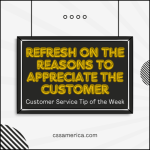
This should be the goal, right? That our clients today will be our clients tomorrow and well into the future. That their loyalty grows, their business with us grows, their referrals grow, and it is all part of a relationship that grows and develops over time.
But what’s the First Step? To answer this question, think about the first step in developing a relationship with anyone – a friend, a co-worker, or anybody else that pops to mind. If the goal is to have a relationship with somebody, we’re not talking about JUST what to do in that instance or that one encounter. We’re talking about how to begin the process of communication and conversation that is going to occur over time. It’s about going beneath the surface to go from chit-chat to rapport to relationship.
Regardless of what event or phone call, what meeting or issue or question created this first encounter, the first real step in creating the customer for life, creating that relationship, is beginning to know the other person.
Who are they? What do they care about? What are their priorities? Who are their friends and family members? Even, what are their values or those things that factor into their decisions?
When you’re thinking about creating that customer for life, before you ever engage anybody, identify what are those things you really want to and need to know about the other person to form a relationship. Write those questions down.
Make some of them a part of every engagement, where you’re not just reacting to them or sharing information with them, but your inquisitiveness and your questions convey that you care enough about them to get to know them a little bit better every time you communicate.
To create a customer for life, take the first step. Know what you need to know.
Signup for FREE Tips! Contact Us More Resources for You Visit Our Home Page























